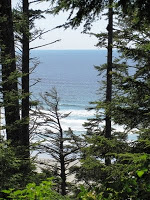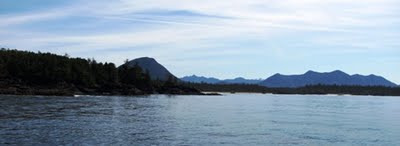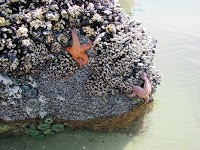If I had to describe Tofino, BC, in one word, I’d say “surfing.” Half the shops in town seemed to be surf shops; the other half were offering tours to see bears, whales, or the hot springs. Even in early June, the public beaches were packed with suntanners and surfers. From Long Beach on Saturday afternoon, we watched a man windsurfing, cutting back and forth across the waves before turning his sail to do it again in the other direction.
 We drove up to Tofino on Friday night and reached our campsite at Green Point Campground just as the sun was sinking. Two young women had been borrowing our site to watch the waves rolling on the beach far below. By the light of our headlamps, I set up the tent, then took the girls to the washroom while my husband spread out sleeping bags. Soon, all four of us were tucked into my two-man backpacking tent.
We drove up to Tofino on Friday night and reached our campsite at Green Point Campground just as the sun was sinking. Two young women had been borrowing our site to watch the waves rolling on the beach far below. By the light of our headlamps, I set up the tent, then took the girls to the washroom while my husband spread out sleeping bags. Soon, all four of us were tucked into my two-man backpacking tent.
On Saturday morning, we woke to sunny skies. Sunshine popped out of her sleeping bag, as fresh as if she’d slept in her own bed at home, and I wished I felt the same way.
A Whale Watching Tour
We boiled water for our oatmeal and packed up the Jeep, then drove into town for our whale watching tour. Sunshine and Lily were excited about the boat, until we got further out of the harbour and into more wind. Then they wanted to go inside—a place I was trying to avoid to make sure that my oatmeal stayed in my stomach.
We saw two grey whales during the two-and-a-half hour tour, but the whales were busy eating and couldn’t care less about who was watching them.
The spectacular scenery was a bit more interesting—snowy mountain peaks, wide sandy beaches, waves rolling against the shore or crashing into rocks, and the big blue ocean spreading out in the other direction. I tried to put what I was picturing together with the map of the island I have in my head. The more I see of Vancouver Island, the more it surprises me. It looks so small on a map, yet there’s so much here.
 Beach Bums
Beach Bums
The afternoon found us back at Long Beach, armed with sunscreen and beach toys. We all ran into the Pacific Ocean before retreating back to a comfortable log to watch the girls dig in the sand. Soon the cool wind had me hiking back up to our tent for my jeans and sweater.
When Sunshine tired of digging in the sand, we wandered down the beach to look at the waves crashing over the rocks, then climbed back up to our tent and drove into Tofino again for Mass at the small but beautiful St. Francis of Assissi Church.
Back at our campground, we built a fire with wood we’d bought last year at China Beach and roasted hot dogs. Then it was time for the girls to go to bed; Lily crashed almost immediately and Sunshine soon snuggled into her sleeping bag too.
My husband and I sat outside, watching the fire burn through the wood, and talked about the weekend and school and the girls and whatever other topic came to mind. Earlier that afternoon, I’d thought how nice it was to just have time together. Nowhere to rush off to, no chores to do—just a big beach to enjoy together.

On Sunday morning, we packed up our campground and then walked back down to the beach. The beach was nearly twice as big as it had been the day before; the wind was gone and so were all the suntanners.
We walked down around the rocks and discovered starfish and anemones in the tide pools, and rocks covered in mussels and barnacles. Every new twist of the beach revealed new sea life to discover, and an hour at the beach to say goodbye turned into two hours of exploring.
Getting to and from Tofino
The drive to Tofino is five hours according to Google maps. I think with stops (hiking Little Qualicum Falls on the way there and Cathedral Grove on the way back, and stopping in various towns to fill up with coffee and gas), it took us about seven or eight hours to make the drive. Despite that, Green Point is one of the nicest campgrounds I’ve stayed at and there were quite a few more hiking trails we could have explored. Maybe we’ll go back again some year.
Looking for some fun books to read with your kids about beaches? Check out if you want to see a whale and The Happy Crab.

2 Comments
Holly – the grey whales can also be identified by the markings on their back. We saw some pictures in the whaling station office of different whales, though I found it hard to tell them apart even with the pictures. Our whaling tour guide said that sometimes he can recognize the whales he sees, but he didn’t recognize the two that we were watching.
We vacationed on a friend’s boat for a week in the San Juan Islands last summer and saw whales while we were there. Friday Harbor has a great little Whale museum, and we learned a lot about the whales in the area. It was very cool.
The Pacific Northwest has been the summer feeding grounds for several pods of killer whales. Pods J, K and L, known as the Southern Resident Community, are generally found in the San Juan Islands/southern Vancouver Island area during the months of May-September.
Each orca can be identified by the shape and size of the fin on its back (dorsal fin) and the gray and white markings beneath and behind the fin (saddle patch). Each animal has been given a pod identification number and a common name which reflects a bit of its heritage, personality or circumstances of its discovery.
We tried to tell who was who, but to be honest, we were not that good—even with our little identification flip chart!